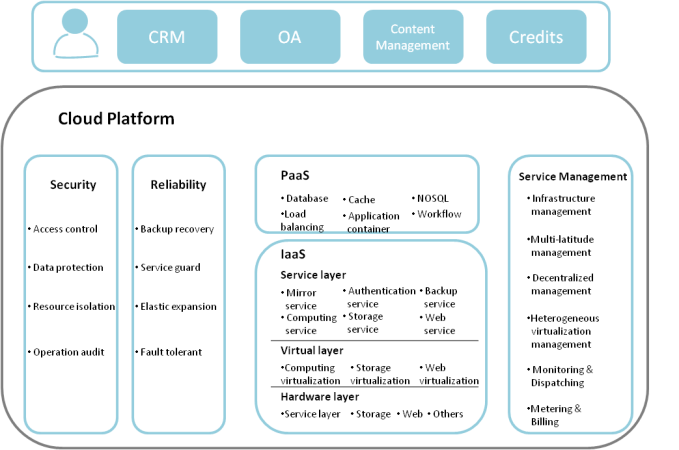The infrastructure of cloud computing is divided into two major parts about service and management. For the service part, mainly to provide cloud services, including 3 levels: IaaS, PaaS and SaaS. For the management part, mainly to provide cloud management, and its main function is to ensure that the entire cloud computing centre can operate with safety and stability, which can be effectively managed. The infrastructure is shown as following:

The core of cloud computing is the computing concentration and scale breakthrough, meanwhile, the provided computing type which decides the hardware infrastructure of cloud computing centre.From the demands of cloud cutomer, cloud computing centre usually needs to provide the scaled types of computing power.And the server system can use three (multi) layer architecture, one is the high performance ,stable and reliable high-end computing, ,mainly dealing with tightly coupled computing tasks, such computing not only includes the key services like external database and data mining of business intelligence, but also including the core system like their own accounts and billings, usually provided by large server of enterprise; Two is for the ordinary general-purpose computing applications, to provide the low-cost computing solutions, such computing has low requirements for hardware, usually with high density and low cost integrated server with high density, then to reduce the operation cost of data centre and the use cost of terminal user; The last is for the business like scientific computing and bioengineering, providing the high performance computing to then million times, and its hardware base is a high-performance cluster.
Based on the standard and openness principle, there is no need to depend on a particular brand of hardware equipment, virtual machine, platform service component in the hardware layer, virtual layer and platform service layer, it can realize the flexible adaptation based on standards. For the so-called elastic, mainly to provide sufficient dynamic stretching capacity, fault tolerance ability and heat migration capacity, then to support for business application and meet the business continuity requirements. Only based on this “open flexibility” can support the final “security”.
没有评论:
发表评论